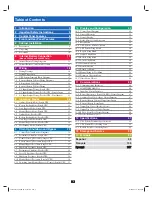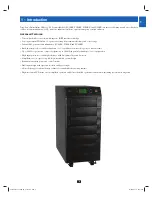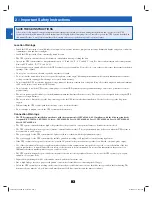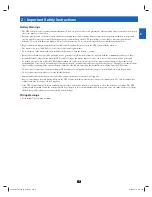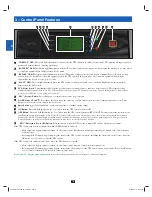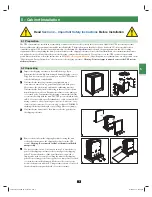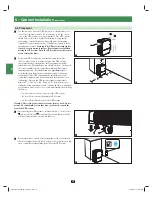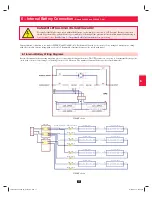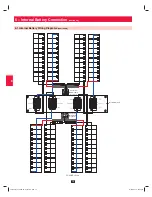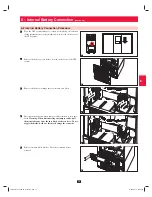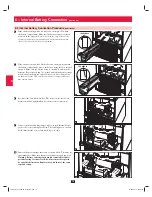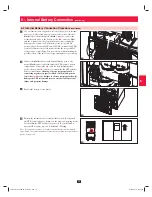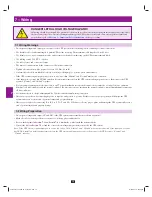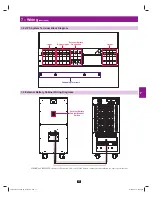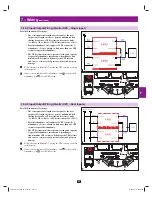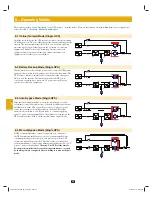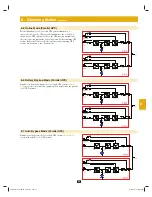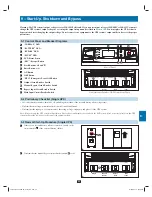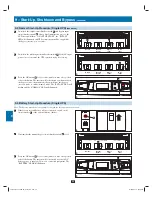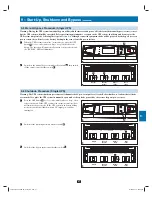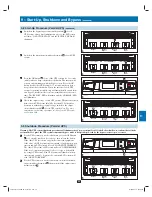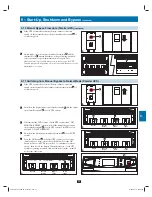
16
1
5
9
3
7
11
2
6
10
4
8
12
13
14
7 – Wiring
DANGER! LETHAL HIGH VOLTAGE HAZARD!
All wiring should be performed by a qualifi ed electrician, in accordance with the warnings in this manual and all applicable
electrical and safety codes. Incorrect wiring may damage the UPS system severely and cause serious personal injury and
property damage. Read
Section 2 – Important Safety Instructions
before proceeding.
7-1 Wiring Warnings
De-energize all input and output power sources of the UPS system before installing cables or making electrical connections.
•
Use flexible cable of sufficient length to permit UPS system servicing. The maximum cable length is 10 m (32.8 ft).
•
Use ferrule caps to cover termination cables and prevent frayed ends from shorting on the UPS system terminal block.
•
Use cabling rated VW-1, FT-1 or better.
•
Use cable sleeves and connector clamps.
•
The neutral conductor must be the same size as the current conductors.
•
Tighten all connections with a torque of at least 3.95 N·m (35 in·lb)
•
Confirm that all cables are marked correctly according to their purpose, polarity, phase and diameter.
•
If the UPS system’s input/output power source is wye-wye, then “Neutral” and “Ground” must not be connected.
•
If the input power source has VNG>0, install an isolation transformer before the UPS system and input power source, then connect the UPS
•
system’s “Neutral” and “Ground” together.
For equipment requiring a neutral connection to an IT power distribution system, the disconnect device must be a four-pole device and must
•
disconnect all line conductors and the neutral conductor. If a disconnect device interrupts the neutral conductor, it must simultaneously interrupt
all line conductors.
Allow the batteries to charge uninterrupted for 24 hours after the initial wiring connection.
•
Observe proper polarity by connecting negative to negative and positive to positive. Failure to observe proper polarity will damage the UPS
•
system and create a serious risk of personal injury and property damage.
Observe proper phase by connecting R to R, S to S, T to T and N to N. Failure to observe proper phase will damage the UPS system and create a
•
risk of personal injury and property damage.
7-2 Wiring Preparation
De-energize all input and output (AC and DC) of the UPS system and external battery cabinet (if present).
•
Mark all cables according to their correct purpose, polarity, phase and diameter.
•
Review the diagrams in
•
Section 7-3
and
Section 7-4
to familiarize yourself with the terminal blocks.
Consult the table in
•
Section 7-5
to find the correct electrical input/output characteristics for the UPS system.
Note: If the UPS system’s input/output power source is wye-wye, then “Neutral” and “Ground” must not be connected. If the input power source
has VNG>0, install an isolation transformer before the UPS system and input power source, then connect the UPS system’s “Neutral” and
“Ground” together.
200706017 93-2688 SU manual 4C.indd 16
200706017 93-2688 SU manual 4C.indd 16
11/29/2007 2:02:36 PM
11/29/2007 2:02:36 PM

